Effect of a neurotoxic dose regimen of (+)-methamphetamine on behavior, plasma corticosterone, and brain monoamines in adult C57BL/6 mice
- PMID: 20096350
- PMCID: PMC2854319
- DOI: 10.1016/j.ntt.2010.01.006
Effect of a neurotoxic dose regimen of (+)-methamphetamine on behavior, plasma corticosterone, and brain monoamines in adult C57BL/6 mice
Abstract
Rationale: In rats, neurotoxic doses of methamphetamine (MA) induce astrogliosis, long lasting monoamine reductions, reuptake transporter down-regulation, and learning impairments.
Objective: We tested whether comparable effects occur in C57BL/6 mice.
Method: C57BL/6 mice were treated with 10mg/kgs.c.x4 MA on a single day and evaluated at various intervals thereafter.
Results: The neurotoxic dose regimen of MA caused the predicted acute hyperthermia and increased striatal glial fibrillary acidic protein and reduced neostriatal dopamine. The MA-treated mice were hypoactive 24h later but not 48h later. MA-treated mice also showed exaggerated initial hyperactivity after a pharmacological dose of MA used to stimulate locomotion followed by a later phase of hypoactivity compared to saline-treated mice. No differences were observed on learning or memory tests (novel object recognition, egocentric, or spatial learning/memory). MA-treated mice showed a trend toward increased prepulse inhibition but not baseline acoustic startle reactivity. After testing, MA-treated mice showed reduced neostriatal dopamine and increased basal plasma corticosterone.
Conclusions: A neurotoxic/binge regimen of MA in mice that produces the typical pattern of neurotoxic changes to those seen in rats, results in few behavioral changes. This may limit the utility of C57BL/6 mice for modeling the cognitive and behavioral effects described in human MA users who show such changes even after prolonged abstinence.
Conflict of interest statement
The authors declare no conflicts of interest for these data.
Figures

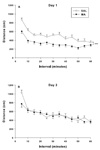
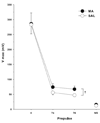

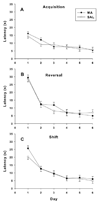
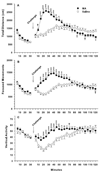

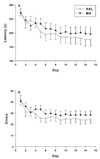
Similar articles
-
Effect of +-methamphetamine on path integration learning, novel object recognition, and neurotoxicity in rats.Psychopharmacology (Berl). 2008 Sep;199(4):637-50. doi: 10.1007/s00213-008-1183-y. Epub 2008 May 29. Psychopharmacology (Berl). 2008. PMID: 18509623 Free PMC article.
-
(+)-Methamphetamine-induced monoamine reductions and impaired egocentric learning in adrenalectomized rats is independent of hyperthermia.Synapse. 2010 Oct;64(10):773-85. doi: 10.1002/syn.20784. Synapse. 2010. PMID: 20698032 Free PMC article.
-
Characterization of binge-dosed methamphetamine-induced neurotoxicity and neuroinflammation.Neurotoxicology. 2015 Sep;50:131-41. doi: 10.1016/j.neuro.2015.08.006. Epub 2015 Aug 15. Neurotoxicology. 2015. PMID: 26283213 Free PMC article.
-
Trace amine-associated receptor 1 regulation of methamphetamine-induced neurotoxicity.Neurotoxicology. 2017 Dec;63:57-69. doi: 10.1016/j.neuro.2017.09.006. Epub 2017 Sep 15. Neurotoxicology. 2017. PMID: 28919515 Free PMC article.
-
3,4-Methylenedioxymethamphetamine (MDMA) neurotoxicity in rats: a reappraisal of past and present findings.Psychopharmacology (Berl). 2007 Jan;189(4):407-24. doi: 10.1007/s00213-006-0322-6. Epub 2006 Mar 16. Psychopharmacology (Berl). 2007. PMID: 16541247 Free PMC article. Review.
Cited by
-
Dopaminergic Neuron-Specific Deletion of p53 Gene Attenuates Methamphetamine Neurotoxicity.Neurotox Res. 2017 Aug;32(2):218-230. doi: 10.1007/s12640-017-9723-z. Epub 2017 Mar 24. Neurotox Res. 2017. PMID: 28342134 Free PMC article.
-
Suppression of endogenous PPARγ increases vulnerability to methamphetamine-induced injury in mouse nigrostriatal dopaminergic pathway.Psychopharmacology (Berl). 2012 Jun;221(3):479-92. doi: 10.1007/s00213-011-2595-7. Epub 2011 Dec 13. Psychopharmacology (Berl). 2012. PMID: 22160138 Free PMC article.
-
A single neurotoxic dose of methamphetamine induces a long-lasting depressive-like behaviour in mice.Neurotox Res. 2014 Apr;25(3):295-304. doi: 10.1007/s12640-013-9423-2. Epub 2013 Sep 26. Neurotox Res. 2014. PMID: 24072398
-
A stress steroid triggers anxiety via increased expression of α4βδ GABAA receptors in methamphetamine dependence.Neuroscience. 2013 Dec 19;254:452-75. doi: 10.1016/j.neuroscience.2013.08.033. Epub 2013 Aug 29. Neuroscience. 2013. PMID: 23994152 Free PMC article.
-
Enhanced neurodegeneration after a high dose of methamphetamine in adenosine A3 receptor null mutant mice.Neuroscience. 2011 Oct 27;194:170-80. doi: 10.1016/j.neuroscience.2011.08.013. Epub 2011 Aug 10. Neuroscience. 2011. PMID: 21867746 Free PMC article.
References
-
- Achat-Mendes C, Ali SF, Itzhak Y. Differential effects of amphetamines-induced neurotoxicity on appetitive and aversive Pavlovian conditioning in mice. Neuropsychopharmacology. 2005;6:1128–1137. - PubMed
-
- Achat-Mendes C, Anderson KL, Itzhak Y. Impairment in consolidation of learned place preference following dopaminergic neurotoxicity in mice is ameliorated by N-acetylcysteine but not D1 and D2 dopamine receptor agonists. Neuropsychopharmacology. 2007;3:531–541. - PubMed
-
- Ali SF, Newport GD, Slikker W., Jr Methamphetamine-induced dopaminergic toxicity in mice. Role of environmental temperature and pharmacological agents. Ann. N. Y. Acad. Sci. 1996:187–198. - PubMed
-
- Alvarez-Fischer D, Henze C, Strenzke C, Westrich J, Ferger B, Hoglinger GU, Oertel WH, Hartmann A. Characterization of the striatal 6-OHDA model of Parkinson's disease in wild type and alpha-synuclein-deleted mice. Exp. Neurol. 2008;1:182–193. - PubMed
-
- Arai S, Takuma K, Mizoguchi H, Ibi D, Nagai T, Kamei H, Kim HC, Yamada K. GABA(B) receptor agonist baclofen improves methamphetamine-induced cognitive deficit in mice. Eur. J. Pharmacol. 2008 - PubMed
Publication types
MeSH terms
Substances
Grants and funding
LinkOut - more resources
Full Text Sources
Medical

